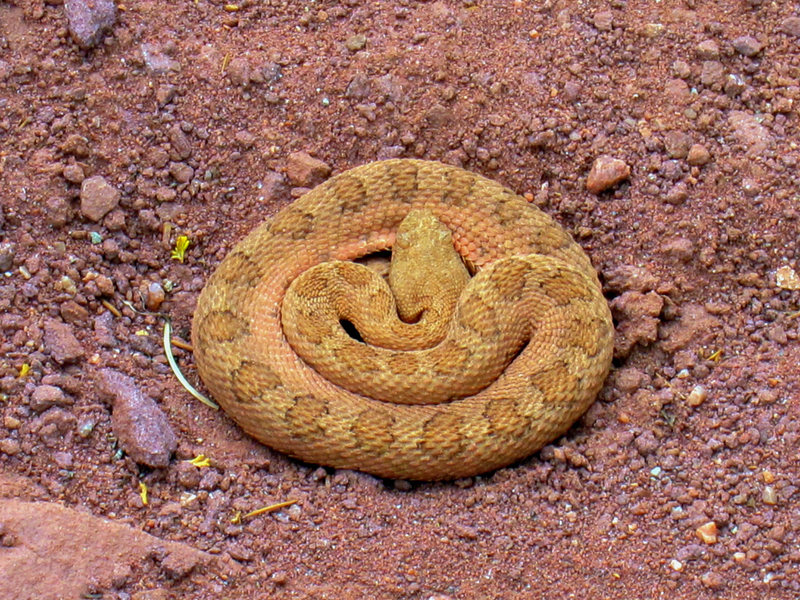Midget faded rattlesnake is a poisonous subspecies of snake occurring in the western United States. The snake is a pit viper.
| Kingdom | Animalia |
| Phylum | Chordata |
| Subphylum | Vertebrata |
| Class | Reptilia |
| Order | Squamata |
| Suborder | Serpentes |
| Family | Viperidae |
| Subfamily | Crotalinae |
| Genus | Crotalus |
| Species | Crotalus oreganus |
| Scientific Name | Crotalus oreganus concolor |
This relatively small-sized rattlesnake is only found in the Colorado and Green River basins of Wyoming, Utah, and Colorado in the United States. It requires rocky hillsides, cliff-faces and slopes with an abundance of crevices & rock cover and sage-brush thickets. Gravid (pregnant) females practice communal thermoregulation, where multiple females use the same spot to sun and give birth. This species generally stays under 3 ft long. Juveniles of the midget faded rattlesnake are typically distinctly patterned, and the pattern tends to fade to a silver or gray as the snakes age. Midget Faded Rattlesnakes are threatened by habitat loss due to infrastructure development (roads, oil & natural gas pipelines, etc.) and by human collection/poaching of individuals and destruction of their hibernacula. Destruction of communal denning (over-wintering) and pregnancy sites can lead to local extirpation (extinction) of populations. It is listed as a Sensitive Species with an S1 rank (high likelihood of extirpation) in Wyoming, and a Species of Concern in Colorado. Both states restrict the collection of this subspecies to permit-only, however, little other action is taken. The midget faded rattlesnake possesses venom more toxic than most other rattlesnakes and any other subspecies under Crotalus oreganus. This is due to a neurotoxin, concolor toxin, as well as a potent mytotoxin. This species exhibits an ontogenetic shift in prey type (favoring lizards or shews over larger rodents) but not a shift in toxicity; venom of juvenile midget faded rattlesnakes are just as toxic as adults of this species.Once considered a subspecies of the prairie rattlesnake (our most widespread and abundant venomous snake), genetic analysis suggests the midget faded rattlesnake is in fact, a subspecies of the "western" rattlesnake.As the name implies, midget faded rattlesnakes are both small (a big one in Wyoming is usually less than 25 inches) and light colored with very limited patterning. This coloration helps this diminutive reptile blend very well with its rocky environment, acting both as a means of defense from predators and camouflage for hunting.This snake is restricted to the canyon habitats associated with the Colorado River drainage. In Wyoming, midget faded rattlesnakes are found in appropriately rocky, cliffy habitats along the Green River and it's tributaries, south of Seedskadee National Wildlife Refuge.Midget faded rattlesnakes are a protected species in Wyoming, but occasionally are killed due to the fact they are venomous. Citizens of the town of Green River encounter this snake quite regularly. If one is located on your property, it is best to contact the Wyoming Game and Fish Department and we will come deal with the docile, but dangerous snake.Venom of midget faded rattlesnakes is quite toxic (one of the most toxic for North America), containing primarily neurotoxins that act upon the nervous system. The LD50 of this venom suggests it is more toxic than some of the Old World cobras. No one should handle this species without good reason. The general public has NO good reason for handling this species and collection of the species is illegal. Remember fellas, youth, alcohol, and snake venom are a very bad combination. Most people bitten by rattlesnakes are either trying to catch the snake, or kill it.Midget faded rattlesnakes feed primarily on cold blooded prey, especially lizards, in part explaining the cocktail of neurotoxins that make up its venom. Rattlesnakes that feed primarily on warm blooded prey typically have venom dominated by haemotoxins, which act upon red blood cells and the circulatory system.

Comments
Post a Comment